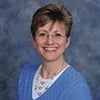Anne Krentz Organ is one of the most popular composers in the Augsburg Fortress catalog. In this interview, we learn how she got started in church music, what she does today, and how she thinks about the creative process.
Could you tell us about your current job/vocation, outside of composing?
I currently serve as the Director of Music at St. Luke’s Lutheran Church in Park Ridge, IL. My responsibilities include worship planning, service playing, and the direction of the choral and instrumental music program which includes adult, youth, and children's choirs, a handbell choir, and a variety of instrumental ensembles.
When did you first start composing?
My first formal attempt at composing came about when I was working on a Certificate of Advanced Studies in Church Music at Concordia University in Chicago. Instead of writing a final paper I opted to compose a set of piano pieces. I had the immense privilege to work with Richard Hillert as my faculty adviser on this project.
How did you become interested in composing?
I came to a career in church music in a roundabout way. I have a bachelor’s degree in piano performance, and a master’s degree in piano pedagogy. Piano teaching was my intended career. But the Spirit works in mysterious ways, and I began subbing for a Saturday evening service. Attendance was around 40-50 people, all of whom went up for communion at the same time, none of whom brought their hymnals along with them. There I would be, week after week, playing the communion hymn(s) verse by verse. That didn’t seem helpful, and at the same time, I was considering what to propose for my final project at Concordia. It occurred to me that some “Reflections” on hymn tunes for holy communion might be useful. I arranged five communion tunes for piano, which were subsequently published by Augsburg Fortress as my first collection of piano arrangements.
What is unique about composing versus other areas of focus, as a musician?
Much of what I do as a musician involves other people: directing choirs, working with instrumentalists, leading assembly song. Composing is a solitary activity, more along the lines of practicing the piano or organ. Composing requires a certain mind set—an ability to concentrate very specifically on the task at hand, and yet also to be open to taking an idea in a new direction. I would guess that most composers are highly self-motivated. Self-motivation plus a deadline is a winning combination.
Could you tell us the story behind one or two of your favorite Augsburg Fortress pieces?
The arrangement of “I Want to Walk as a Child of the Light” for instrument and piano in Woven Together is dedicated to my son Paul. Paul was 5 or 6 years old at the time, an exuberant child who was going through a skipping phase. Why walk when you can skip? I tried to capture the ebullience and light-hearted joy of skipping by writing parts of the piece in 5/8 meter, keeping the melody in 6/8.
The choral arrangement of the “Canticle of the Turning” was written for one of the annual Candlelight Service of Lessons and Carols at St. Luke’s. This year will be the 79th incarnation of the service. It’s a big deal at St. Luke’s! We include all the choirs, from the littlest kindergarten singers up through the youth and adult choirs, and an array of instrumentalists including a Flute Choir, Recorder Consort, Orff Ensemble, Handbell Choir, Brass Ensemble, and Chamber Orchestra. The Canticle of the Turning lent itself well to use by multiple choirs—verses being assigned to a variety of voicings, with piano and instrumental accompaniment, and an opportunity for the assembly to join in singing the refrain.
View and order Anne’s pieces on the Augsburg Fortress website:




